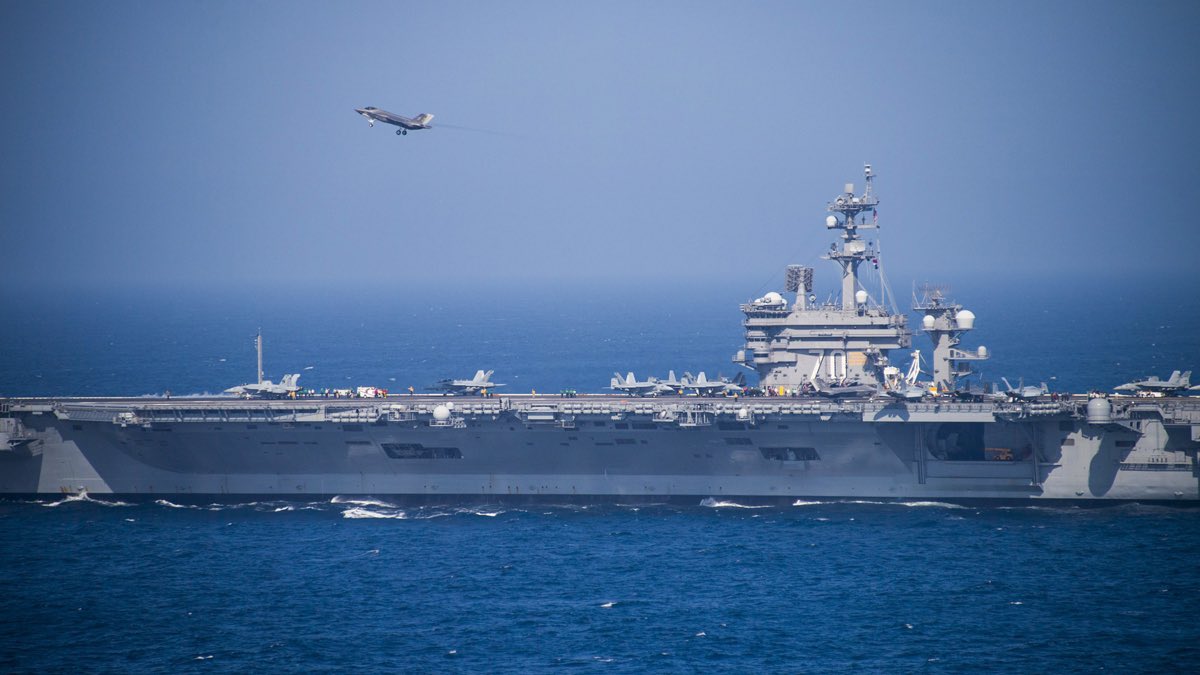US Navy’s Future Carrier Air Wing Likely To Double The Fleet Of Stealth Fighters — Top Official
A “super squadron” of roughly 20 F-35C stealth fighters could be added to the US Navy’s carrier air wing in the future, said a senior official. His remark comes days after F-35C fighter jets returned from their first operational cruise aboard the USS Carl Vinson, a Nimitz-class carrier (CVN-70).
The aircraft carrier returned home on February 14 following a six-and-a-half-month deployment to the Indo-Pacific, marking the first deployment of the US Navy’s “future air wing,” comprising the F-35C Joint Strike Fighter, EA-18G Growlers, and E-2D Advanced Hawkeyes.
The first deployment also witnessed a landing disaster involving an F-35C. Nevertheless, the Navy seems upbeat about its F-35C fleet.
“Right now, we’re probably going for a 14-aircraft squadron,” Rear Adm. Dan Martin, commander of the Carl Vinson Carrier Strike Group, said at a press briefing. “I’ve heard noise of us thinking around the possibility of going to a 20-aircraft squadron.”
The 10 F-35Cs from Strike Fighter Squadron 147 (VFA-147), the “Argonauts,” were “seamlessly integrated” into the air wing, according to Martin. A pair of new EA-18G Growler electronic attack planes and one more E-2D Advanced Hawkeye radar plane had previously been added to the air wing for this cruise.
This deployment, according to Martin, demonstrated a paradigm shift in the way the aircraft carrier and strike group deploy. The new carrier air wing vision, which Martin claims is currently being evaluated, might be the latest in a line of changes to the F-35C force structure.
Initially, the Navy planned to deploy two F-35C squadrons per air wing, each with 10 aircraft. In September 2020, Rear Adm. Gregory N. Harris, director of the Air Warfare Division, sketched out plans for an air wing with 16 F-35Cs in one squadron. By the middle of 2021, however, that single squadron had been shrunk to 14 jets.
Shortage Of Space
The carrier air wing has had 44 strike fighters for this entire time, with the service now considering the best combination of F-35Cs and F/A-18E/F Super Hornets to tackle its tactical fighter shortage.
It’s uncertain how the addition of a “super squadron” of F-35Cs would affect F/A-18E/F numbers, but one alternative is to go back to the initial arrangements, which called for 20 F-35Cs and two 12-aircraft Super Hornet squadrons.
Despite the Navy’s plan to expand the number of EA-18Gs and E-2s, the problem of space above and below decks becomes particularly crucial. Some crew members on the carrier told Defense News that they grappled with the high “deck density” or the frequency of aircraft compared to the amount of space on the flight deck and in the hangar bay.

Smaller than the Super Hornet, but F-35C requires more and larger ground support equipment. Adding more F-35Cs without creating space for them on the flight deck won’t help, but Martin insists the new fighters will add significant capabilities for the strike group.
It seems efforts were undertaken to make more space on deck and in the hangar and that was before the carrier embarked on its deployment. Capt. P. Scott Miller, the Vinson’s commanding officer, previously acknowledged that a number of treadmills and workout equipment lying on the hangar deck had also been removed.
According to Martin, the Navy has begun to cut down on the number of helicopters sent to an air wing, which may free up space for more aircraft — but he said he had 19 helos and “needed all of them.” Anti-submarine warfare, surface strike, search and rescue, logistics, and other duties are all carried out by the MH-60R/S Seahawks.

The US Marine Corps also operates its F-35C squadrons from aircraft carriers. Marine Fighter Attack Squadron 314 is currently aboard the USS Abraham Lincoln, making the F-35C’s second carrier deployment, as part of a goal to have four F-35C squadrons prepared for carrier deployment.
The Marines are working on F-35C deployment methods, which include an initial focus on using austere land bases, but it’s unknown whether the service’s squadrons will be expanded.
Reasons Behind ‘Future Air Wing’
The new air wing concept stemmed from the realization that carriers and their associated aviation capabilities will play a major role in the near future.
“This is just a complete change, with a near-peer competitor, with activity that is in the air, on the surface of the sea and below the surface of the sea,” Martin stated. “You have to shape the air wing to best handle that activity.”
It’s no mystery that China and the Indo-Pacific are on the Pentagon’s radar, as indicated by the US’ recent release of an Indo-Pacific strategy white paper and the Vinson’s recent deployment of the 7th Fleet in the Indo-Pacific region.

The “Navy Aviation Vision 2030-2035” stressed the need to win in the great power competition with Russia as well as China. According to the Navy, the Future Air Wing “will be increasingly lethal, survivable, networked, sustainable, and unmanned with autonomous capabilities. Integrated passive and active sensors will provide battlespace awareness for the CSG and Fleet Commander.”
The F-35C excels in this area, because of its mix of low observability, combat radius, superior sensors, and networking capabilities.
Increasing the number of EA-18Gs and E-2s in the air wing also contributes to this goal. While the Growler helps combat the expansion of multi-layered air defense systems that are expected to be engaged in a Pacific conflict, having more Hawkeyes allows the air wing to have situational awareness.
Martin stated that he wants to add more EA-18Gs to the seven-plane fleet already on board the Vinson, which was two more than the standard.

![DVIDS – Images – USS Ralph Johnson’s Visit, Board, Search and Seizure Team Meets with Indian Navy Sailors aboard INS Mumbai [Image 6 of 7] DVIDS – Images – USS Ralph Johnson’s Visit, Board, Search and Seizure Team Meets with Indian Navy Sailors aboard INS Mumbai [Image 6 of 7]](https://101veterans.com/wp-content/uploads/2024/12/dvids_logo_20_main.png)